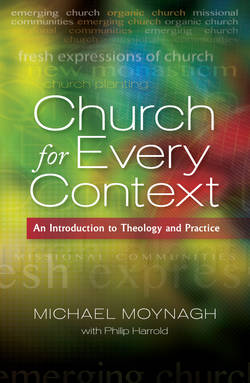Читать книгу Church for Every Context - Michael Moynagh - Страница 87
Questions for discussion
ОглавлениеMuch of this chapter has been about official support for new contextual churches. What should individuals and churches do when this support is not present? How far does the spread of new contextual churches depend on official support?
Do you agree that the mixed economy in Britain could yet stall? If so, what would avoid this?
What are the lessons from Britain’s experience? If you were advising your network or denomination, what strategy would you suggest for multiplying contextual churches?
1 What counts as a ‘fresh expression of church’ is contested. The term certainly includes what I am calling ‘new contextual church’, but – as used in this chapter – fresh expressions also includes initiatives that would not strictly fit my definition.
2 For an accessible introduction, see Johnson (2002) and Wheatley (2006).
3 This is the strong version, which holds that a system can have qualities not directly traceable to its components but only to how they interact. New qualities are irreducible to the system’s constituent parts, so that in principle the system is unpredictable. A weak version of emergence holds that new properties arising in a system have characteristics that derive from existing elements in the system, as well as from the interactions between these elements. What emerges is predictable in principle because the new properties have some of their origins in the characteristics of the elements, but it is not predictable in practice.
4 Taking a different approach, Kester Brewin has argued that ‘the God who created evolution and dreamt up emergence’ has eschewed a purely top-down system of communication and chosen to ‘re-emerge’ within creation, bottom up, through Christ (Brewin, 2004, pp. 44–5). A fuller account than the one here might describe how the Spirit, acting on behalf of God’s coming reign, nudges creation toward the kingdom. If self-organization produces ever high levels of complexity, as theorists argue, the kingdom – to which creation is being drawn – can be seen as the ultimate level of complexity.
5 An alternative way of looking at the figures suggested that the percentage could be 4 per cent, still a sharp decline (Brierley, 2000b, p. 98).
6 Expressions: the dvd – 1: Stories of church for a changing culture, produced by Norman Ivison and available from www.freshexpressions.org.uk.
7 Theologically, this is interesting. The statement could be challenged if God is seen as a ‘stable system’, unchanging through and through, for this ‘stable’ God also innovated in bringing creation into being. On the other hand, if God is unchanging in his character but there is movement in his internal relationships – Fiddes likens them to a dance (2000a, pp. 72–81) – then the statement would be consistent with our understanding of God.
8 In 2009, Bishop Graham Cray, who had been Bishop of Maidstone, was appointed the Archbishops’ Missioner and Team Leader of Fresh Expressions.
9 At the time of writing, the Church of Scotland seems likely to do so too.
10 ‘A fresh expression is a form of church for our changing culture established primarily for the benefit of people who are not yet members of any church.
It will come into being through principles of listening, service, incarnational mission and making disciples.
It will have the potential to become a mature expression of church shaped by the gospel and the enduring marks of the church and for its cultural context.’ (Croft, 2008c, p. 10).
11 Expressions: the dvd – 2: Changing Church in Every Place produced by Norman Ivison, available from www.freshexpressions.org.uk.
12 Share has now been incorporated in the main Fresh Expressions site (www.freshexpressions.org.uk), but can still be accessed through its original web address.
13 The literature distinguishes between different types of attractor. See, for example, Stacy, Griffin and Shaw (2000, p. 87). A good introduction to the concept of ‘strange attractors’ can be found in Wheatley (2006, pp. 115–34).
14 In addition to works already cited, Chiles, Meyer and Hench (2004) provide a helpful application of the dissipative structure model to organizations. Their article made a significant input into the Lichtenstein/Plowman model.
15 Press Release, 19 January 2012.
16 Estimate provided by Bob and Mary Hopkins in January 2011.
